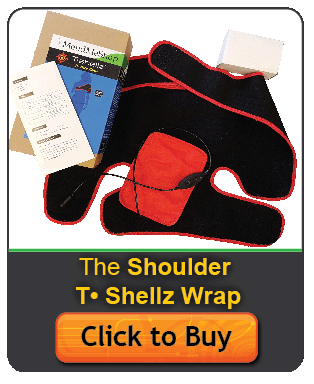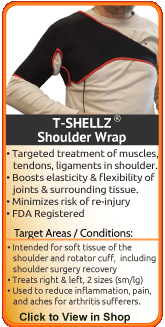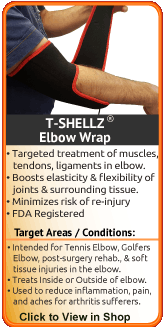|
| Shoulder Instability and DislocationShoulder instability is a condition where the soft tissues that hold the humeral head (top of the upper arm bone, the humerus) against the glenoid cavity (at the glenohumeral or shoulder joint) in place, are no longer able to. As a result, the humerus is allowed to slide around (called subluxation), or in some cases, come right out of the socket, often referred to as 'popping' out of the socket or dislocation. Anatomy of the Glenohumeral JointThe many joints, ligaments, tendons, labrum, and muscles of the shoulder allow for an incredible range of motion. However, due to the wide range of motion and flexibility, the shoulder is also very unstable. The glenohumeral joint is a ball and socket joint similar to the hip, but the ball doesn't sit in the socket as deep. The humeral head sits against the glenoid cavity more like a golf ball on a tee. This means the shoulder relies on the soft tissue in the shoulder socket to hold it in place. The ligaments in the shoulder that are largely responsible for stability are called the coracohumeral ligament, the superior glenohumeral ligament, the medial glenohumeral ligaments, and the inferior glenohumeral ligament. There are also ligaments within the shoulder joint capsule that help to stabilize the glenohumeral joint. The joint capsule is a watertight sac that contains fluid to lubricate the joint. The walls of this joint capsule are ligaments that attach to the humeral head, restricting the distance the humeral head can come out of the capsule. The muscles and tendons of the rotator cuff that support the glenohumeral joint include the supraspinatus, the infraspinatus, the teres minor, and the subscapularis. The tendons create a 'cuff' at the outer edge of the shoulder and surround the glenoid cavity and humerus for stability. The tendons attach the muscles to the bones in the arm and shoulder, allowing movement when the muscles contract. Shoulder InstabilityIf any of these supportive muscles, tendons, and/or ligaments become fatigued, weakened, injured or overstretched, the head of the humerus can slip out of the glenoid cavity easily making the shoulder unstable. Damage to the ligaments, tendons, and/or muscles in the shoulder from a past accident or a fall can often lead to subluxation (joint sliding around) happening from seemingly unrelated activities. This is often referred to as post traumatic instability. When this occurs, shoulder instability can become a chronic problem with the shoulder popping out of place on a regular basis. At times, dislocation of the glenohumeral joint may occur. It is often hard for people to get the shoulder back into place on their own, and this can mean a painful trip to the emergency room every time the shoulder pops. Dislocations can cause nerve damage within the shoulder joint and can be very painful. Dislocation in the shoulder can happen in a particular direction or in more than one direction. The injury is usually classified based on the direction the humeral head moves out of the joint:
Anterior dislocation is the most common of these classifications, making up approximately 90-95% of all shoulder dislocation injuries. Regardless of the direction of dislocation, the ligaments, labrum, and other connective tissue that holds the humerus in the shoulder joint become stretched and can no longer hold it close causing instability. What are the Symptoms of Shoulder Instability?
Causes of Shoulder Instability
Surgical Repair for Shoulder InstabilityThe most common surgery for stabilizing the shoulder is called a Bankart repair. It is commonly performed arthroscopically through several small incisions around the shoulder joint. Several tiny incision are made for the arthroscope (a pencil sized-camera) to view the damage in the joint capsule from different angles. The surgeon will remove any bone spurs or degenerative tissue and then reattach any torn ligaments to the glenoid cavity. This is usually done with special 'suture anchors' that hold the ligaments in place and will dissolve over time as the tissue heals. Another type of surgery that is used to stabilize the shoulder is called a Capsular Shift. This procedure is used when the shoulder capsule itself is too large, which causes instability in many directions for the patient. The joint capsule being too large may be referred to as a redundant or patulous joint capsule. The joint capsule must be tightened in order to make it more stable. A capsular shift can be done with arthroscopy as well. The surgeon will connect a flap of the tissue in the joint capsule to another part of a joint capsule, creating a pleat-like structure. Recovery time for surgery will depend on a number of different factors including your healing ability, diet, rest and how many procedures were done during surgery. Your doctor will advise you on your recovery and let you know if/when physical therapy can be started. Treating Shoulder Instability - What You Can Do!If you suffer from shoulder instability, rest is recommended. However, some careful shoulder movement is required to prevent the joint from freezing and losing range of motion. See your doctor or physical therapist for stretches that will not cause further injury to your rotator cuff. Avoid activities that cause pain or may have caused the injury and begin cold compression treatments as soon as possible. The trick to healing your shoulder instability is getting the connective tissue surrounding the glenohumeral joint back to normal. The ligaments and tendons that have been stretched can heal and stabilize your shoulder again and you want them to heal as close to the healthy, elastic tissue they once were so you have the same flexibility and range of motion in your shoulder that you have always had. Healing with minimal scar tissue is the only way to do this - something Circulatory Boost is great at! Even with optimum healing, there is always less elasticity in previously injured rotator cuff tendons, muscles and ligaments. However, if you heal your unstable shoulder properly and treat scar tissue build up, your chance of re-injury, chronic instability or other shoulder conditions later on is much lower than average. There are home treatment tools that can help treat your rotator cuff tendons, labrum, and coracohumeral and glenohumeral ligaments to speed up the healing process so you can get back to a life faster, without pain and risk of further injury. Circulation Boost (via the TShellz Wrap®) will treat scar tissue and promote blood flow to heal your glenohumeral joint faster and more completely than any other methods available. Although steroid injections may provide temporary relief from the pain of shoulder instability they should generally be avoided as they weaken tissue and may lead to a complete rupture. If you do opt for an injection, doctors usually recommend that you do not participate in strenuous activities for several weeks to reduce the risk of a rupture. A Cold Compress or Ice Pack for Inflammation ReductionTo decrease inflammation and relieve the pain of shoulder instability doctor's recommend cold compression. Following a fall or other acute injury that caused the shoulder instability and after any re-injury, cold compression within the first 48 - 72 hours is important to limit the amount of damage done to your tissue. Cold compression will relieve pain and swelling as needed and will reduce, or even eliminate, the need for NSAIDs. Cold works by interrupting and slowing nerve and tissue function in the injured area and reducing swelling that can block blood vessels. This is important because once blood vessels are blocked or damaged, they can no longer carry oxygenated blood through your labrum and tissues begin to break-down. Without cold compression damage continues as tissues break-down - they cannot get the oxygen they need to survive. By limiting the amount of damage done to your tissue, you also limit the amount of healing that needs to occur. This is a very important step to heal your SLAP tear faster and with less pain! Application of a Cold Compress or Ice Pack reduces tissue damage. Furthermore, because cold will numb the nerves, the wraps also reduce pain! Once swelling is down, we recommend the use Shoulder TShellz Wrap®. This home treatment tool is a highly effective conservative therapy that will help heal your connective tissue quickly and keep them flexible and elastic. The use of a TShellz Wrap® will speed recovery, combat excessive scar tissue growth, help prevent re-injury and heal your rotator cuff and glenohumeral joint more completely. Some of our customers have used this wrap to reduce their chance of needing Bankart Repair surgery. This treatment will help prepare your shoulder for strengthening exercises while reducing the risk of re-injury. Talk to your doctor or physical therapist to find out which exercises are appropriate for your situation. If you do undergo a surgical procedure, know that the Shoulder TShellz Wrap® is also a highly effective tool for Post-surgery rehab. Click here to read more about post-surgical rehabilitation. TShellz Wrap® - Circulation BoostThe rotator cuff naturally receives a limited blood supply and when you stop moving your shoulder because it hurts the blood flow is reduced even further, limiting your body's natural ability to heal itself. By treating your rotator cuff with Circulatory Boost you can increase your body's blood supply to the shoulder and increase your body's natural healing power. A Shoulder TShellz Wrap® is the tool you need to treat your sore shoulder because it speeds healing and relaxes the surrounding muscles, tendons and ligaments. Through a process we call Circulation Boost, soft tissue in the shoulder are safely and gently stimulated. Your body responds with a rapid increase in blood flow to the area, increasing the supply of oxygen and nutrients to injured tissue to promote healing. Our Shoulder TShellz Wrap® provides effective, non-invasive, non-addictive pain relief and healing with no side effects. Enhanced blood flow from a TShellz Wrap® treatment whisks away dead tissue and toxins that have built up from your damaged rotator cuff. When you stop moving your arm and shoulder due to shoulder pain, your muscles and other tissue can become weaker and dead tissue and toxins in the area can cause further tissue deterioration - this can lead to atrophy. By clearing the area of toxins and increasing the amount of oxygen and nutrients to your muscle and other tissue, the risk of atrophy (muscle weakness and/or deterioration) is greatly reduced. Keeping your upper arm, shoulder and rotator cuff tissue as healthy as possible throughout the healing process will allow you to improve shoulder strength again once your pain has gone and your tear has healed. Not only does the incorporation of conservative treatments (such as the use of a Cold Compress or Ice Pack and the Shoulder TShellz Wrap®) make up a valuable component of your everyday home recovery plan, but it helps to prevent long term complications. Chronic pain, lack of mobility, or arthritis in the shoulder are some of the more common long term complications that can occur when rotator cuff tears go untreated. By treating your rotator cuff with the Shoulder TShellz Wrap®, joint elasticity increases, scar tissue growth is minimized and the labrum and other tissue becomes stronger reducing the risk of chronic problems in the future. During the healing process, scar tissue will build at the location of the tear. In addition, scar tissue will bind muscles, ligaments and other tissue together in the injury area. This inflexible scar tissue limits the movement of these connective tissues that were once elastic making movements painful and essentially reducing your shoulders' range of motion over time. As a result, movement of the entire joint is limited making it difficult to lift your arm or to reach for objects. If left untreated, the shoulder may 'freeze' (a condition called frozen shoulder or adhesive capsulitis) altogether making movement impossible. At the very least, scar tissue leaves your shoulder joint weaker, leaving your shoulder and rotator cuff at greater risk of further injury - this is why we urge people to incorporate the Shoulder TShellz Wrap® into their treatments! It is really an essential tool for rehabilitation and prevention of chronic (long term) injury and joint atrophy. We recommend that you consult your doctor and/or physiotherapist before using any of our outstanding products, to make sure they're right for you and your condition. During your recovery, you may have to modify and/or eliminate any activities that cause pain or discomfort in your rotator cuff area until your pain and inflammation settle, and you gain more mobility and strength in your shoulder. The more diligent you are with your treatment and rehabilitation, the faster you will see successful results! Click HERE to Go To Our Online Store We take all major credit cards and Paypal. Product specialists are available 9:00 am to 5:00 pm Eastern Standard Time Monday to Friday. If any question or concern arises, call us or simply send us an email at any time (we check our emails constantly all throughout the day and night.. even on holidays!). We will respond as soon as possible. North America Toll Free 1-866-237-9608 |
|
















